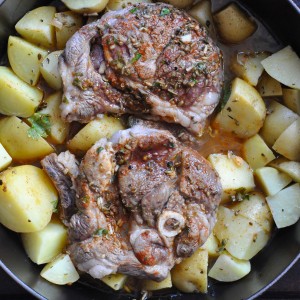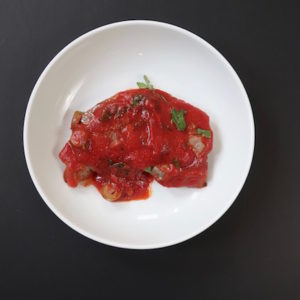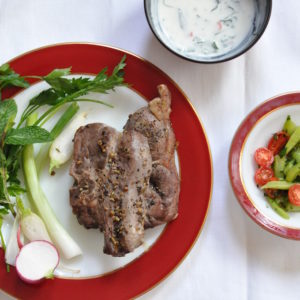Lamb with Spring Vegetables
Lamb with Spring Vegetables might more aptly be titled: how to save dinner when you buy the wrong ingredients. Which is what yours truly did.

Not the original ingredients.
I stared at the recipe I’d meant to cook for a while, then at what I actually bought. Dinner needed cooking. A blog needed posting.

My back is starting to go again, so God knows how long I’ll be able to keep at this before visiting the cortisone gods. (two weeks). I stood in the kitchen for a good ten minutes before figuring out what to cook: lamb chops on a bed of spring vegetables. Granted, this is not the wheel, or the re-invention of tahini. But it was a nice dinner, which is about all we can hope for these days.

Baby artichokes are taken for granted by Northern Californians, who have the luxury of living near Gilroy, the nation’s capital of artichoke production. (One reason why we pay insane mortgages.) Feel free to substitute whatever is available near you.

This is not an artichoke. You know this. I know this. The artichoke picture, it was not so good. Now this picture, we can all agree, is much nicer than the artichoke picture. Okay, well, you didn’t see the artichoke picture, so how can you agree? Trust me. You can. Do I lie about pictures?
Moving right along.
Fava beans also seem to be a specialty vegetable, with a short season. They are a faff to prepare, needing podding and then a brief bath in boiling water to loosen their skins, but I love fava beans, so tolerate the fuss.

Lamb with spring vegetables requires little by way of seasoning: salt and pepper will do nicely. Fennel seeds add much, if you are so inclined, as does ground pomegranate seed, available in Indian markets or online. Those fond of sour flavors might try either preserved lemon or sumac–but not both. No need for overkill.

Serve the lamb with yogurt, flatbreads, and a big bowl of rice.

Lamb with Spring Vegetables
Serves: Three lamb chops served two people with leftovers; scale up or down accordingly
Prep time: Fava beans need podding, then a quick boil to soften their outer skins, which must be peeled. If fava beans are unavailable or too much bother, substitute another spring vegetable, like green beans or zucchini. Artichokes must also be prepped–a matter of pulling off the external leaves and trimming off sharp bits. Cooking time is about an hour.
Please read notes before beginning to cook.
About 1 pound/454 grams fava beans, in the pod, to give about 3/4 cup/340 grams beans, prepared (see below for prep instructions.)
baby artichokes; I used six for two people, see below for discussion of prep
olive oil, for the pan
2 spring onions or scallions, trimmed and sliced thinly
1 lobe shallot, peeled and sliced into half moons
2-3 cloves garlic, peeled and minced
3 lamb shoulder chops, bone in; approximately 1.5 pounds/680 grams, left whole
1 teaspoon fennel seed (optional but delicious)
salt and pepper; I used Maldon sea salt, but regular table salt is fine
1-2 tablespoons tomato paste
2 cups tomato sauce using whole roma tomatoes
optional seasoning:
either 1 teaspoon sumac or
preserved lemon, to taste
a dash of white wine
Preheat the oven to 300F/150C.
Take the lamb out of the fridge so it can come to room temperature.
It’s best to prepare the fava beans now, but if you’re short time, you can get the lamb started and add the fava beans to the braise midway–I’ve done that. But for now, let’s prep the fava beans first.
Put a small pot of water on the stove to heat up–low heat is fine.
Pod the beans into a bowl. Once they’re all podded, bring the water to a gentle boil and drop the beans in. Let them simmer for three minutes, and fish a large one out with a slotted spoon. Cool the bean under running water, and test it with a fingernail. If you can pierce the skin easily with your nail, turn off heat and remove the rest the beans, spooning them back into the podding bowl.
Save the water for prepping your artichokes.
While the beans cool, get on with trimming the artichokes. You will need either a little vinegar or lemon juice. I prefer lemon, as the flavor harmonizes with the lamb dish.
If you prefer not to dirty another dish, you can toss the trimmed chokes directly into the pot. Or carefully pour the now-warm water into a clean bowl. Either way, squeeze a goodly amount of lemon juice (or pour about a tablespoon white wine vinegar) into the water–say, half a lemon. If you have sensitive skin or any cuts, you may want to wear gloves.
Break off the outer leaves of the artichokes until you reach the smooth, pale green inner leaves. If your artichokes have long stems, leave them on. Peel them, as you would a carrot, and trim the bottom. Saw off the artichoke’s pointy top with a serrated knife. Toss the now-trimmed artichoke into the lemony water.
Once all the artichokes are trimmed, leave them soaking. They may brown a bit, which is fine, as you will be cooking them. Turn to your now-cooled fava beans. You can either peel them into a pile or use another bowl. Either way, peel them, and as every recipe says, set aside.
You’ll need a oven-safe pot large enough to hold the lamb and vegetables in one layer. Lidded is ideal, but you can always use foil.
Place the pan on a burner, and pour in enough olive oil to generously cover the bottom. Heat to medium.
Add the spring onion, garlic, and shallot. Cook, stirring, for a few minutes. If anything appears to be burning or browning too rapidly, turn the heat down.
Lay the chops in the pan. Add the tomato paste and pour over canned tomato sauce.
Arrange the fava beans and artichokes around the lamb. Season with fennel seed, if using. Add salt, pepper, and optional sumac or preserved lemon. Add dash of wine, if using.
Cover pan with lid or tinfoil. Using oven mitts, place pan in oven and cook for 45 minutes, check lamb at 30 minute mark for liquid and doneness.
Lamb is done when tender and pink–but not raw.
Serve with green salad, if wished, yogurt, rice, and flatbreads.
The dish will improve if refrigerated, well-wrapped, up to three days.
The lamb may be frozen up to two months. While the vegetables may be frozen, they will suffer loss of texture and flavor.
Notes:
It’s difficult to give weights for vegetables, as they grow to the sizes they are; buy what you think your family will eat.
As noted above, if fava beans and artichokes are unavailable, other vegetables may be used; consider green beans, wax beans, zucchini, yellow summer squash, eggplant, fresh or frozen peas, even canned tomatoes.
Any cut of lamb will work here, but larger, bone-in cuts like shoulder and shank will require longer cooking times. To avoid a tough exterior, turn the oven down 25 degrees.
As sumac and preserved lemon are both souring agents, don’t use both to season the dish–choose one or the other.





